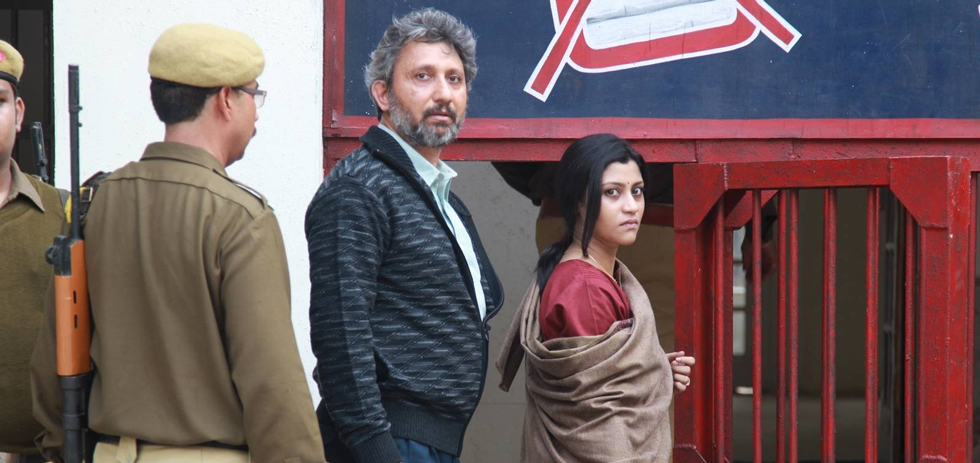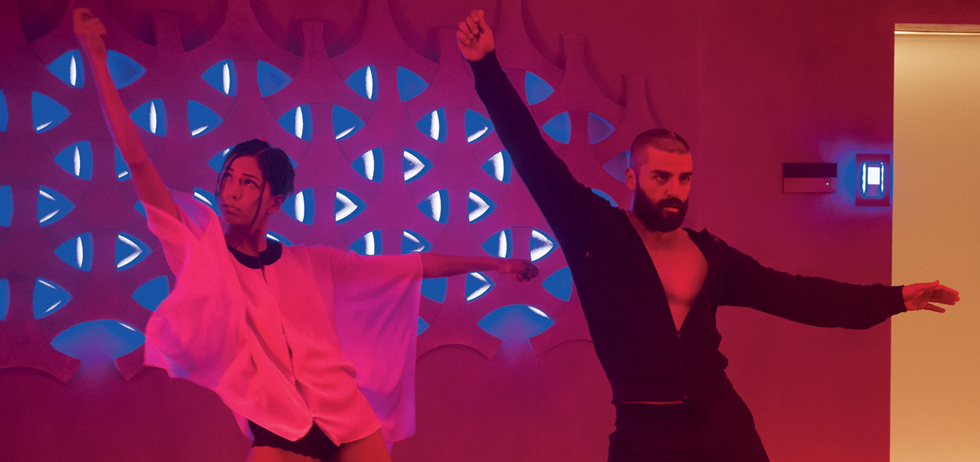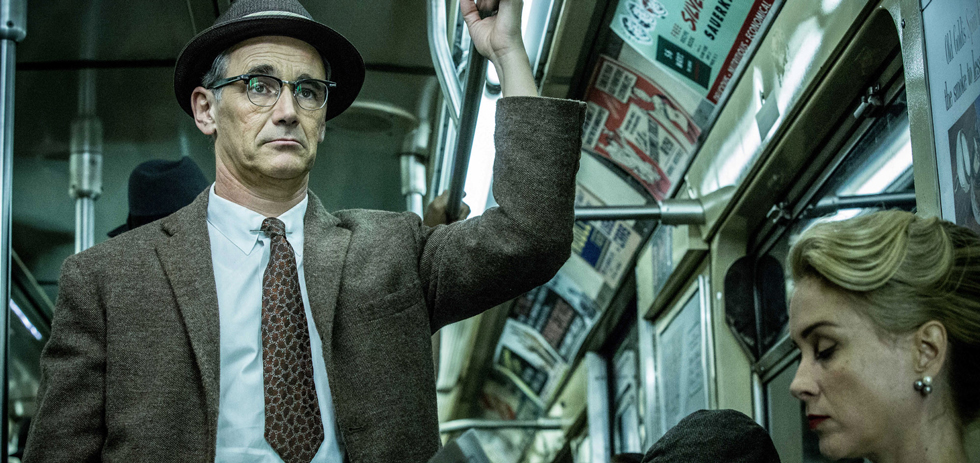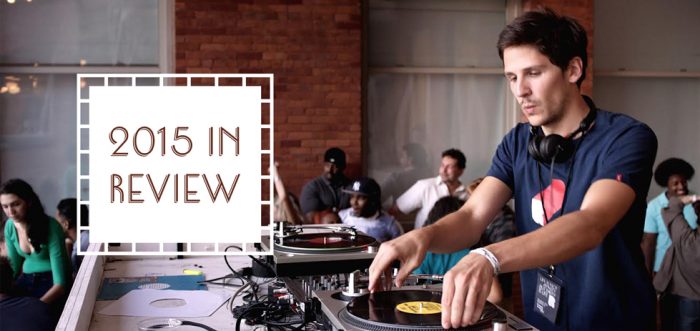The Grab Bag is our way of collecting together some of our favourite moments and elements from films this year. The guidelines for submission were intentionally vague so what follows is an amusing and eclectic group of favourites, from film scores to dual performances, politics in a Sandler film to a slow dissolve.
Conor Bateman: I know I waxed lyrical (pun intended) on the music in Mia Hansen-Løve’s Eden in my review of the film earlier this year but I can’t stress enough how fantastic that film’s soundtrack and presentation of music is. As much as I really want to see the film again at home (it’s one of my favourites of the year), I doubt any experience other than theatrically will capture the immersive nature of the musical sequences. From the enchanting credits sequence featuring Derrick May’s “Sueño Latino (Illusion First Mix)” to the heartbreaking use of Daft Punk’s “Within”, Hansen-Løve maps the musical evolution of the French Touch and Garage House scene alongside the emotional stasis of protagonist Paul.
To switch gears a bit, I want to talk about a slow dissolve in Apichatpong Weerasethakul’s Cemetery of Splendour. It occurs about halfway through the film, after volunteer nurse Jenjira (Jenjira Pongpas Winder) and narcolepsy-suffering soldier Itt (Banlop Lomnoi) go to a cinema. The film is a schlocky Thai genre picture, and during the screening Itt passes out. We then cut to a set of escalators in the shopping centre where the cinema is, they bisect the frame. As we see two men start to carry Itt out a slow dissolve begins to the vivid green fluorescent poles at the end of the hospital beds of other recovering soldiers. It’s perhaps the most stunning and meditative moment in a film full of them.
Jeremy Elphick: Although far from perfect, one of the films that stuck with me most throughout the year was Stranded in Canton, particularly because of the way in which the filmmakers created a sort of geopolitical emotional landscape, that wove existential ennui and emotional disconnection into more political commentary on the long lasting effects of colonialism, political corruption and capitalism. This was overwhelmingly indebted to the visual construction of the work; broad contrasts in cinematography that place the lone protagonist against huge backdrops of industrial factories and beige landscapes, and an absolute absence of the West – from people, to companies, to imagery. One of those films that, despite a fairly skeletal plot, manage to really excel through visual engagement.
Sound design has always been a really huge part of relating to films for me. There’s an almost endless list of otherwise stunning works (documentaries are especially guilty of this) that fall on inappropriate soundtracking, or simply lazy stock-music to provoke emotion. This was one of my favourite things about Mediterranea; the precision in the choice of music throughout. Specifically, it was in the ability to re-contextualise and shift audience perception in the use of music. It’s hard to explain in any depth without spoiling the film, but with each time Rihanna’s “We Found Love” is played throughout the work, the audience is significantly more likely to burst into tears.

Felix Hubble: There’s something fascinating about the politics on display in Pixels; Adam Sandler is a known Republican supporter and conservative to boot,1 however the discussions of self-esteem and self-value, the importance of the working class, workers rights, and the inherent classism of those in roles of power almost approach a cracked form of Marxist politics. It’s a film where Adam Sandler, an everyman who works at Radio Shack is literally best friends with the president (played by Kevin James, another everyman), who consults his buddy at every opportunity, and relies on his unique skill-set as a commoner to defeat video-game based invaders. It attacks those who try to force class divide and shames those who attempt to belittle or devalue the proliteriat, and on those grounds alone marks a huge departure from the other droll, blockbuster trash of its ilk, one hugely underappreciated by mainstream film critics upon the film’s release.
I was also particularly impressed with the way in which the team behind Unfriended committed to their gimmick of their entry into the platform horror canon. It’s a film that will undoubtedly age poorly but acts as a brazen document of the way that youth cultures interact with technology in this particular era. Wrapped in a morality tale that isn’t meant to be taken seriously, acting as a means to justify the real point of this project: Skype horror – Unfriended acts as a pleasant reminder that there’s still obvious formal territory left untread in contemporary mainstream horror cinema, and even simple, obvious, and extremely dumb ideas can be ultra-effective on their target audience. Kudos, Blumhouse.
Ali Schnabel: It’s been a good year for soundtracks and scores. My favourite score of the year was from Sicario; Icelandic composer Johann Johansson’s brutal composition complimented the narrative of the film just so bloody well. The ominous percussive onslaught was always there, rumbling in the background, ready to burst forth and traumatise you aurally at any moment. The brooding of the harsh strings and relentless drums both complement and cement the film, for me.
Another soundtrack with a similar pulse-manipulation effect was Disasterpeace’s amazing effort on It Follows, utilising synths-aplenty to set the eerie mood so thick it was almost tangible. Final soundtrack nod goes to Tangerine, a trap heavy set that runs perfectly parallel to the ADHD-esque turn of events in the film.

Virat Nehru: With a willingness to play with form, convention, narrative and stylistic expectations, it’s as exciting a time as any to get involved with what Indian cinema has to offer, especially if the dominant image in your mind is one purported by Bollywood: songs, dances and extravagance galore with a bit of story thrown in to hold it all together. There is no better example of this new face of Indian cinema than Court. The film cleverly uses long and drawn out legal procedural scenes to punctuate the absurdity of being caught up in the Indian justice system. The lawyers read out long passages of legislation word for word and court typists wait for the magistrate to dictate legal procedure. These scenes build-up to the false ending: a wide shot of the empty courtroom as the lights go out one by one. It’s such a delightful scene – the institutional embodiment of oppression and cruelty captured in all its glory.
On the other hand, anything that Vishal Bhardwaj touches is turning to gold right now. There is a particular way he constructs narrative that is uniquely appealing. You can see it in his Shakespearean adaptation trilogy and you can see it in Talvar. Bhardwaj uses the Rashomon device so cleverly, infusing the age-old technique with freshness. It transforms the narrative from what initially appears to be an investigative procedural to a quest to understand human behaviour. And talking of Talvar, how can we forget the versatility of Neeraj Kabi? He has played two dynamically opposite characters this year: from a completely over-the-top, almost comic-book style villain in Detective Byomkesh Bakshy! to an emotionally subdued, grieving father of his murdered daughter in Talvar. His ability convey emotion through non-verbal communication such as subtle expressions or movements is immensely captivating. It also allows the audience to be more of an active participant in the viewing experience, a welcome change in the age of passive consumption.
Ian Barr: It’s a bit of a waste of space defending a generally acclaimed and commercially successful film, but I thought I’d throw in a defense of Yorgos Lanthimos’ The Lobster, since its dismissals in the insular world of the critics I generally follow (aka my Twitter timeline) seem to outnumber its fans. On the one hand, I can understand the arguments against it: Lanthimos’ proclivity for 1:1 allegorisation of his themes (just as in Alps and Dogtooth) invites not-invalid criticisms of gimmickry and obfuscation, especially if you’re not in sync with his sense of humour. What I can’t understand is how even fans of the film see a failure on his part to move beyond the thematic implications of its initial setup – a dystopian satire set in an alternate-reality/near-future in which being single is a crime punishable by law – especially since its second half shifts gears to satirise the mindset of the viewer who’d find that setup so unambiguously delightful. Indeed, among the film’s greatest virtues is its self-effacement, and how it complicates viewer identification, beginning as a tidy, even pandering satire of the codification of romantic connection as shaped by stifling societal norms, and then broadening its aim to skewer those who reject those norms so thoroughly as to accept equally arbitrary, stifling rules.
Less a parable or allegory, then, The Lobster wields its absurdism – peppered with lashings of outright sadism – in service of something more experiential than intellectual, alternately heightening and defamiliarising the feeling of loneliness and despondency that affects those who’ve been inculcated with binary views of intimacy and connection (the film is titled after its protagonist’s obliging answer to a question that, in the utopian flipside to the world depicted, needn’t be asked), embodied in the dual authorities depicted in each half of the film. Lanthimos’ well-exhausted trope of the quaintly amusing dance sequence, for instance, is well-represented in the hotel scenes and later rhymed with a glimpse of a ritual silent disco amongst the film’s group of woods-dwelling ‘loners’, hilariously depicting absurd pageantry on two sides of the same coin. That Lanthimos creates a love story between two of these people that’s alternately sweet, compassionate and finally terrifying (aided immensely by Colin Farrell and Rachel Weisz’s spot-on performances, perfectly in sync with the film’s exacting tone) is the film’s masterstroke.

Tope Ogundare: Being the greedy little boy that I am (or perhaps the generous little boy, depending on whether contributing to this Grab-Bag is an act of giving or taking), I shall list five items; five handfuls.
1: Oscar Issac’s tech tycoon Nathan Bateman breaking into dance in Ex Machina remains one of this year’s giddiest surprises; an instance of mildly deranged levity in an otherwise buttoned-down film. Maybe the moment proved so potent because it was the first outright evidence of Bateman’s simmering loopiness, one which I had suspected from his initial introduction. On a more envious note, between his supreme moves in this scene, his folksy turn in Inside Llewyn Davis, and his 70’s-Pacino-brilliance in Show Me a Hero, Oscar Isaacs has clearly been granted more than a fair share of talent.
2: Here, I nominate one of the more widely circulated posters for Pablo Larrain’s El Club, a film which is probably on my top ten list in a parallel universe. A snot-yellow, schematically drawn, 6-windowed house is superimposed over a hazy grey image of a cliffy stretch of coast. This drab combination of the opaque and the sickly stark is an unnervingly apt representation of the film itself, thematically, tonally, visually. The Catholic Church’s nauseating non-secret stowed away in plain sight, daring its victims to ruin themselves by unearthing buried trauma while daring society at large to keep its eyes averted. One could even call the poster a too obvious rendering of ‘the banality of evil’ which, if true, is nonetheless part of its power.
3: Towards the end of Denis Villeneuve’s Sicario, a team of shady CIA operatives prepare to storm a tunnel through which a Mexican cartel has been needling contraband across the Mexico-US border. As dusk and nighttime meet somewhere in the wilderness, genius cinematographer Roger Deakins manages to capture a resplendent sliver of grapefruit sky sandwiched between voluptuous blue storm clouds above and murky green border plains below. Plopped in the foreground are the tar black silhouettes of the tunnel-stormers all decked out in their bulky gear, night-vision goggles perched atop their helmets like feathery crowns standing attention on the heads of a flock of rare bird. Deakins’ eye is the behind-the-scenes VIP of this very serviceable thriller, and these few seconds are – to me – its zenith.
4: “Witness me, brother!” It’s the line bellowed out by the diseased-looking War Boys featured in Mad Max: Fury Road as they prepare to martyr themselves for their beloved leader Immortan Joe (and in an instance of dramatic irony, the ‘traitor’ Imperator Furiosa). Director George Miller and his laudable editor Margaret Sixel ramp up the speed of the image ever so slightly as an impaled War Boy blasts metallic spray paint across his mouth in a fit of delirious devotion, and then implores that his fellow cannon fodder, his brothers in arms, ‘witness’ as he leaps onto an enemy vehicle, destroying it and himself in the process. It’s an image of fundamentalist aggression and delusion which few films have, in my recent memory, rendered so chillingly. Not quite as fun as the Doof Warrior, but equally as stirring, and impishly inventive in its own right.
5: Provided that the gently lisping charm of Lola Kirke will – hopefully – be a dependable element of many cinematic years to come, let me forego expanding on her performance and single out the moment from Noah Baumbach’s Mistress America in which Greta Gerwig’s comically insightless socialite Brooke Cardinas attempts to pitch old frenemy/romantic rival, Mamie-Claire, a business proposal. When Mamie-Claire responds with the ‘I’m too busy’ excuse, Brooke turns to her pseudo-protege Tracy (Lola Kirke) and proclaims: “remember this truth: It’s only people who don’t have jobs and don’t have anything to do that are always fucking BUSY,” before swiftly turning on Mamie-Claire and yelling, “like what are you DOING?!” Okay. Does it deserve to be THE highlight of Mistress America? Probably not, but it is for me.

Dominic Barlow: How many Millenials have gotten to age 23 without seeing a single Spielberg in the cinema? I suspect I’m not alone here, and that his filmography, long and nigh-synonymous with Western cinema as it is, has found increasingly fragmented audiences in recent years. For my part, I’ve encountered him via casual TV flick-ons (Hook reruns), film-scholarly DVD rentals (Jaws, A.I.), or the odd end-of-term high school viewing that always ended too early (War of the Worlds). I’m sure, at least, that many of our age will have consciously passed on Bridge of Spies and its dad-pleasing story of masculine derring-do and international diplomacy. It’s their loss, since his elemental craftsmanship hasn’t gone anywhere (yet, bafflingly, his name is barely touched on in the advertising), and this is represented nowhere better than the deft opening scene, where Soviet spy Rudolf Abel evades FBI agents in the streets of Brooklyn. Watching this sequence play out in its intended cinema home – shot and cut with such careful geography by mainstays Janusz Kamiński and Michael Kahn, yet with a total absence of score; a silver lining of hesitancy from John Williams’ absence, perhaps? – made it an utter bolt from the blue, and in the middle of it, we’d be remiss to forget, is the magnificent Mark Rylance, who gives an understated performance worthy of the Coen brothers who have script credits on the film. He’s getting an Oscar nod come January, right?
Surely there was a bigger youth turnout for Focus, a forgettable crime thriller about a pair of sexy con artists played by Will Smith and Margot Robbie. Most of the screentime is spent watching cons unwind and multi-millionaire baddies be outwitted, but then along comes a left-field sequence that miraculously wound up in the trailer and has lodged in my memory ever since. In brief, we jump from Smith and Robbie skipping Argentina with millions of ill-gotten dollars to the heavy-for-hire that hunts them down and take them in for questioning from his boss (Rodrigo Santoro). What’s strange is the self-containment of this sequence, starting with the soothing song choice of “White Bird” by 60s psych outfit It’s a Beautiful Day, and continuing in the detailed observation of this heavy working the job into his night activities, as performed by non-actor Dotan Bonen.2 He picks up his required tools from the pharmacy (shrugging off an odd look from the checkout girl as he goes), has a solitary drink in a cantina buzzing with excitement over a televised soccer match, then dons a neckbrace, mouthguard and helmet and ferociously ploughs his four-wheeler into Smith and Robbie’s sports car, the wreck of which is slow-revealed in a lens-flared, hobbling handheld shot (DP Xavier Grobet, who also worked on TV’s Looking). Gordon, as the character is called, is then relegated to the background to nurse a bloodied gash while his boss hammily pokes Smith for answers. This finale busies itself wrapping up the long con, but for my money, I wanted to follow this bruiser out the door and back into the Buenos Aires streets to the next job, or to his home, and find out more about him. Here’s hoping directors Glenn Ficarra and John Requa sneak further subtle pleasures into their future films.
Kenneth Kriheli: [spoiler alert for the film Phoenix incoming] One of the most important aspects of Christian Petzold’s Phoenix is how it illustrates a Holocaust narrative. What’s first important is that the Holocaust and the film’s postwar period setting are depicted as part of the past, yet both are distinct from one another in that the latter is never shown. It’s all too easy and crude to cut to flashbacks of concentration camps or Nazi glory, but as expected of late theorist and filmmaker Harun Farocki’s final screenplay, Phoenix‘s narrative proves as intelligent as it is economical by avoiding that. Second, the Holocaust (and war)-as-past is psychologically and semiotically embedded underneath visual surfaces of the period-setting-as-present. There are the more obvious examples of this, like the reconstructed face of protagonist Nelly Lenz (Nina Hoss) and the ruins of Berlin, but then there are much more provocative moments that bear Farocki’s trademark. This first occurs at the end of the opening sequence, when we cut from a POV shot of a bandaged Nelly unfolding a photograph of her old self with pianist husband Johnny (Ronald Zehrfeld) to one of her friend Lene Winter (Nina Kunzendorf) searching a photograph of human bodies with a magnifying glass. The latter shot focuses on the tool’s enlarged image, obscuring the tool itself and the all-too-recognizable picture into a blur of black and white until we cut away from her putting the photograph aside to verify identification of another friend and victim. Both women are stuck in two very different kinds of pasts from which they are ironically far removed—Johnny secretly divorced Nelly as a second-class citizen, and Lene escaped the camps altogether in Switzerland—but Nelly’s romantic longing is the opposite of Lene’s dealings with an almost dissociative trauma, completely intangible and yet palpable and horrific.
It is Nelly, the literal and later symbolic survivor, who ultimately tries to reconcile the two as she completes her reunion with her opportunist ex. Her singing and her tattoo in the minimalistically last-minute climax and denouement signify entirely different things as she finally accepts the dissolution of her fantastic desires and forces Johnny to recognize her. Her familiar voice singing a Kurt Weil tune in English signals the uncanny, while the blue digits on her now-naked forearm are so bluntly confrontational and undeniable that an eyeline match with Johnny’s gaze forces him to stop his accompaniment altogether, leaving Nelly to sing a cappella. As it turns out, the titular, mythical bird is a symbol of self-realization, not of rebirth; Phoenix the film, then, is less a replication or reevaluation of the Holocaust and its legacy (and there are few such Holocaust films that aren’t that) than it is about the burdensome task of truly reflecting upon it.
